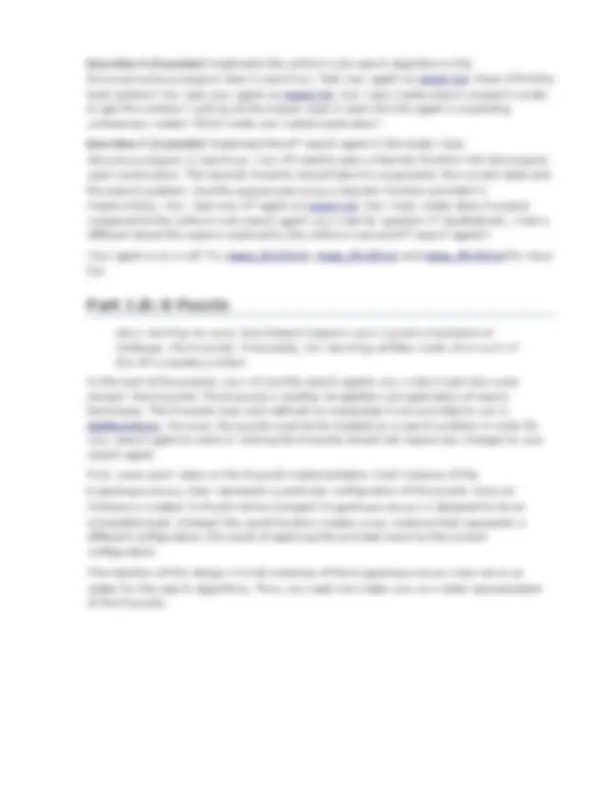





Study with the several resources on Docsity

Earn points by helping other students or get them with a premium plan


Prepare for your exams
Study with the several resources on Docsity

Earn points to download
Earn points by helping other students or get them with a premium plan
Community
Ask the community for help and clear up your study doubts
Discover the best universities in your country according to Docsity users
Free resources
Download our free guides on studying techniques, anxiety management strategies, and thesis advice from Docsity tutors
Material Type: Assignment; Professor: Harter; Class: Artificial Intelligence; Subject: Computer Science - CSCI; University: Texas A & M University-Commerce; Term: Fall 2007;
Typology: Assignments
1 / 7

This page cannot be seen from the preview
Don't miss anything!




A lone adventurer, the brave SearchAgent, forges eastward through the mountains with nothing but a map and her algorithmic savvy. Only by a thorough search of her map will she reach her destination without wasting steps.
While future projects will tackle realistic present day AI applications, this one focuses on two classic domains in the artificial intelligence community: mazes and the 8-puzzle. After some brief exercises to help familiarize you with Python and the provided code base, the project will consist of building general search algorithms and then applying them to multiple domains. If you are unfamiliar with Python, you should have worked through a Python Tutorial on your own before this project. The code for this project consists of several Python files which you will need to understand in order to complete the assignment. You can download the code and supporting files as a hw2.tar.gz archive (http://faculty.tamu- commerce.edu/dharter/tamu/classes/2007fall/csci538/labs/hw2.tar.gz). mazeworld.py Code for constructing, editing, displaying and searching mazes (Part 1.A). search.py Generic search algorithm code (Part 1.A). All your search agents will implement the solve method for the empty SearchAgent classes in this file. A summary of the search API can be found here. util.py Useful data structures for implementing search algorithms (Part 1.A). eightpuzzle.py Code for constructing, editing, displaying and searching 8-puzzles (Part 1.B). You will implement the EightPuzzleSearchProblem class and two heuristic functions. What to submit: You will edit portions of search.py and eightpuzzle.py during the assignment. You should submit them along with a text or pdf file containing transcripts of your code working and answers to the discussion questions.
For the first part of your assignment, you'll be writing search agents which solve the maze search problem. The relevant code is in mazeworld.py. A maze is represented as a 2-d grid with a start position 'S' and exit 'E'. There are also obstacles '#' that are impassable and water '~' which is passable but expensive (5 times the step cost of moving through a blank square). For example:
|# |
To create this simple maze, you can type:
import mazeworld simpleMaze = mazeworld.Maze([['#', ' ', ' ', ' '], ['~', 'S', ' ', 'E']]) print simpleMaze The simplest agent in this domain simply moves right until she finds the exit or hits an obstacle and gives up. This simple agent, SimpleMazeAgent, is provided in mazeworld.py. This agent can find a path through our simple maze. simpleMazeAgent = mazeworld.SimpleMazeAgent() mazeworld.testAgentOnMaze(simpleMazeAgent, simpleMaze) Solution cost: 2. Number of nodes expanded: 2 Number of unique nodes expanded: 2 You can also see a visualization of the maze solution by passing an optional verbose =True to testAgentOnMaze. Question 1 (1 point) Write a function that creates the simple maze above and then edits it such that the simple right-moving agent cannot reach the exit. Now, write a maze agent that can solve your new maze (hard-coding a sequence of moves is fine). You need only submit a transcript of the output for this question. Now that you've gotten your feet wet, it's time to write full-fledged generic search agents! Question 2 (3 points) Implement the depth-first search (DFS) algorithm in the DepthFirstSearchAgent class in search.py. Make your algorithm complete, for example by checking for cycles in the search path (Section 3.5). Test your code on the maze in maze1.txt as follows: maze1 = mazeworld.readMazeFromFile('maze1.txt') import search agent = search.DepthFirstSearchAgent() mazeworld.testAgentOnMaze(agent,maze1,verbose=True) What is the cost of the solution found by your depth first search agent? Is this the lowest cost solution? If not, what is depth-first search doing wrong? Question 3 (3 points) Implement the breadth-first search (BFS) algorithm in the BreadthFirstSearchAgent class in search.py. This time, write a graph search algorithm that avoids expanding any already visited states (section 3.5). Test your code on the maze in maze1.txt the same way you did for depth-firstsearch (except of course instantiating your BFS agent instead of your DFS agent). Does your BFS search agentfind the best solution. Now test your BFS agent on maze2.txt. Does your BFS agent findthe best solution for this maze? If not, what is BFS doing wrong, or failing to do?Does your BFS agent expand a substantially different number of nodes than your DFS agent?
Question 6 (3 points) Fill in the missing elements of EightPuzzleSearchProblem so that the breadth-first search agent can find a solution. Then, test your agent interactively as follows:
import eightpuzzle import search puzzle1 = eightpuzzle.loadEightPuzzle(1) puzzleProblem1 = eightpuzzle.EightPuzzleSearchProblem(puzzle1) bfs = search.BreadthFirstSearchAgent() bfs.solve(puzzleProblem1) Will the BFS agent always find the optimal (fewest moves) solution to an 8-puzzle? Question 7 (4 points) Write the two heuristic functions that appear in the textbook for this problem: misplaced tiles and distance (section 4.2). Compare the performance of A* using each of these heuristics on the provided puzzles. Extra Credit (2 points) A third heuristic, Gaschnig's heuristic , is derived from the problem relaxation that a tile can move from a square A to a square B if B is blank (p. 108). Specify this heuristic and find an efficient way to compute it. Implement the heuristic. How does it compare to the two heuristic functions in question 8 (in terms of A* performance)? Can you quickly write a heuristic function that is always at least as good as the and Gaschnig's heuristics?
Squares are either marked as revealed (and therefore clear) or hidden (possibly a mine, or possibly clear). All revealed squares show the number of adjacent squares, including diagonals, which have mines (in most programs, zeros are displayed as blanks). At each step, we select a hidden position to reveal. We win if we reveal all clear squares without revealing a mine. We can use CSPs to gather information about unknown squares for a
a. Formulate a CSP where a solution is an assignment of the hidden squares to {clear, mine} which is compatible with the observed adjacent mine counts. Assume the number of remaining mines is unknown. b. Sometimes we have to guess. Show a small, simple board configuration for which no hidden square is guaranteed to be clear, and show the set of solutions to the CSP. c. Sometimes we can reason that a certain hidden position is guaranteed to be clear. Show a small, simple configuration which has more than one solution, but where all solutions agree that some currently hidden position is clear. Show those solutions. d. Why will a standard CSP solver not directly tell us where to move next? e. How can we augment the basic DFS-based backtracking constraint solver to tell us whether or not a square is guaranteed to be safe? f. Can we still use forward checking with the augmented DFS-based backtracking constraint solver from part e)? Why or why not? What about arc consistency? g. [Extra Credit: 2 point] Show a method for correctly deciding which move is safest when no move is perfectly safe.